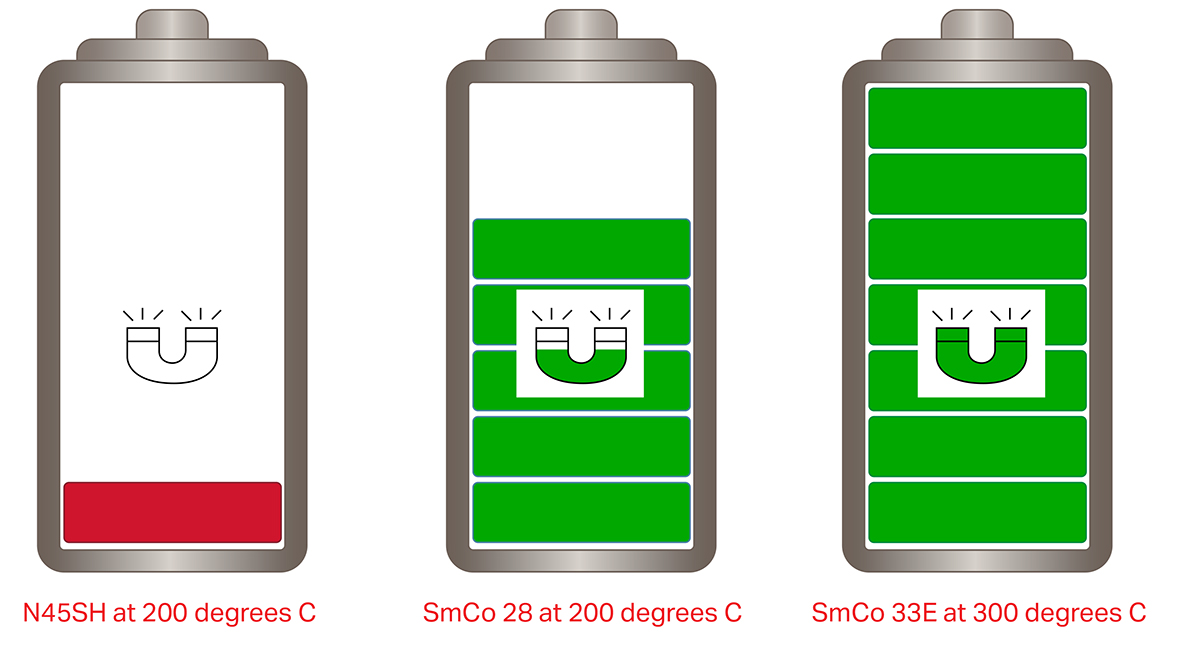XGS33 Expands Bunting Samarium Cobalt Magnets Range
Bunting’s range of Samarium Cobalt (SmCo) Rare Earth Magnets now includes the XGS33 grade, which provides higher stability and magnetic performance at raised temperatures

Such performance characteristics are critical in applications for the automotive, aerospace and electronics sectors.
Bunting is one of the world’s leading designers and manufacturers of magnets, magnet assemblies and magnetising equipment. The Bunting European engineering and manufacturing facilities are in Berkhamsted and Redditch, both in the United Kingdom.
Rare Earth magnets made from Samarium Cobalt (SmCo) were originally developed in the early 1960s, much earlier than the more widely known and used Neodymium Iron Boron (NeFeB). The energy density of SmCo 2:17 is similar to the very high coercivity grades of NdFeB (e.g. AH grades) magnets, with the advantage of significantly enhanced coercivity, meaning the magnets can run faster, hotter and harder without demagnetising.
This increased coercivity comes through carefully controlled processing and thermal treatment and does not need any addition elements, unlike NdFeB, which requires a very high percentage of the scarce rare earth element Dysprosium (Dy) to maintain magnetic performance in difficult environments.
Samarium Cobalt’s higher coercivity (i.e. being able to withstand an external magnetic field without becoming demagnetised) leads to use in extremely demanding applications where temperatures exceed 300°C. As there is barely any free iron in the magnet material composition, SmCo is suitable for use in corrosive environments, without a coating. When a suitable coating is applied, SmCo magnets are almost impervious to corrosion.
High-speed magnet rotors, with rotational speeds exceeding 100,000 RPM also feature SmCo magnets. Such challenging environments are found in the automotive (especially motorsport), aerospace and electronics industries with electric motors, sensors, and high efficiency magnet rotors. Being slightly more dense means that SmCo magnets can run hotter. In operation, the eddy currents generated by such rapid rotation warm the SmCo magnets, but do not demagnetise them.
The newly introduced XGS33 grade of SmCo starts outperforming N42 grades of NeFeB at around 170°C and continues to maintain strong magnetic properties up to 350°C. The XGS33 grade also produces the highest magnetic performance in the SmCo range with a maximum energy product (BHmax) of 32 MGOe.
“Technological advances, especially with green technology, continue to drive development of magnet materials,” explained Matthew Swallow, Bunting’s Technical Product Manager. “The new XGS33 grade of Samarium Cobalt further enhances the performance of the rare earth magnet, enabling users to considering harsher environments previously unthinkable.”
CONTACT
Simon Ayling
Bunting - Berkhamsted
sales.berkhamsted@buntingmagnetics.com
www.buntingeurope.com
+44 1442 875081
Wednesday 3 February 2021 / file under Aerospace | Automotive | Electronics


